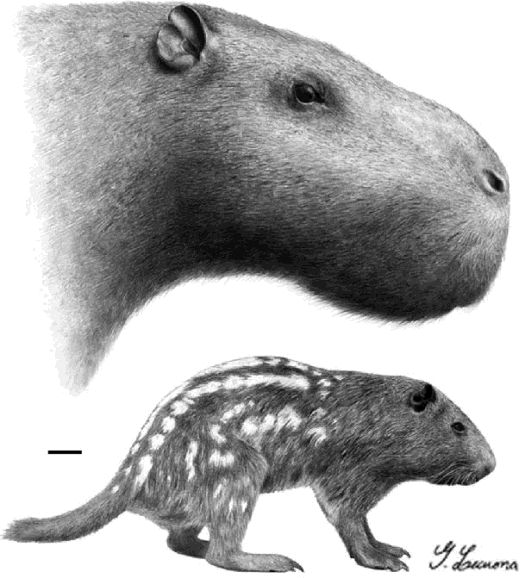|
Giant rodents ancient and modern
The past month has proven quite eventful on the giant rodent scene. In mid-December, science news circles were abuzz over the discovery of a rat in the isolated Foja Mountains rainforest of western New Guinea that is believed to belong to a species new to science. (Click here for photo.) Then just two weeks ago the journal "Proceedings of the Royal Society B" described the skull of a rodent from Uruguay believed to have lived about one million years ago. The living rat weighs about three pounds (1.4 kg), making it five times the size of a typical city rat and almost twice the weight of the previous record-breaker, the 1 lb 11 oz South America giant water rat. Using keenly-honed techniques, careful examination of the skull of the fossil rodent suggests its long-dead owner would have felt quite at home standing alongside a field full of one-ton stud bulls, making it the largest rodent known to science ever to have lived. By way of comparison, few rodents today exceed two pounds in weight. The most massive living rodent, the capybara of South America, barely nudges the scales to the 130 pound (60 kg) mark. So one ton comes as quite a surprise, even to those familiar with the concept of giant creatures in bygone ages.
Before we run away screaming at the merest mention of the word "rodent", may we pause to remember where rodents came from - not from the bowels of hell, as some might imagine, or the demented mind of some imaginary Demiurge, but off the drawing board of the One who assures us that everything He made is very good. He seems to have a special affection for rodents since fully "40% of the total number of mammalian species recorded" belong to the order Rodentia (Rinderknecht and Blanco, "The largest fossil rodent", Proceedings of the Royal Society B, January 2008). We all love squirrels, guinea pigs, and beavers; they, too, wear the rodent badge of honor. Every creature, including rats and mice, give testimony to the genius and wisdom of the Father of Jesus Christ, the Creator of everything in heaven and on earth. If only we could rid our minds of received hatred of any of God's creatures and instead marvel at their brilliant design and consider the
|
contribution they make to the cycle of life we would find inspiration for the soul in the most unexpected of places.
Back to the story. The giant New Guinea rat, dubbed "Mallomys giant rat" for the moment, was discovered in June, 2007, when it fearlessly entered camps of equally fearless scientists who had entered the steamy, pristine "lost world" to study and film its denizens. So far, little more has been reported in the news or in journals than the basic facts given here.
More has been said, albeit almost all of a technical nature, about its dear departed Uruguyan "relative", remains of which were found in a boulder broken off a cliff face. Dubbed (obviously without its permission) Josephoartigasia monesi, the extinct Goliath belonged to a rodent family, the Dinomyidae, that has but one living member, the little-known forest-dwelling, tropical pakarana. Don't let the paucity of living members of the family mislead you; fossil remains of about fifty extinct species have been found in South America. The oldest remains go back roughly 30 million years, but the lion's share of species lived from two to twenty million years ago. Little is known of their biology "because most of the fossils recovered are isolated teeth and incomplete mandibular remains". However, the great diversity of their dental shapes and sizes shows they occupied many different ecological niches for the past 30 million years in South America, with grazing possibly being their main method of gaining nutrition. Josephoartigasia appears to have munched on aquatic plants and fruits, yet it sported fearsome front teeth which may have been used to fight over females for breeding rights (assuming it was male) or have helped defend against predators, including carnivorous marsupials, saber-toothed cats and giant meat-eating birds. In short, this newly-discovered giant serves to shine the spotlight on a whole array of wondrous creatures that long ago peopled this fabulous planet we call home and, as if to humble us, did so for much, much longer than the human race ever will. Glorified saints, of course, will personally enjoy earth's delights for considerably longer than extinct races of animals.
|





